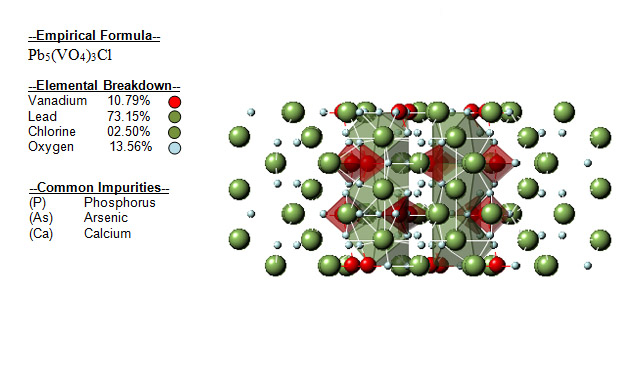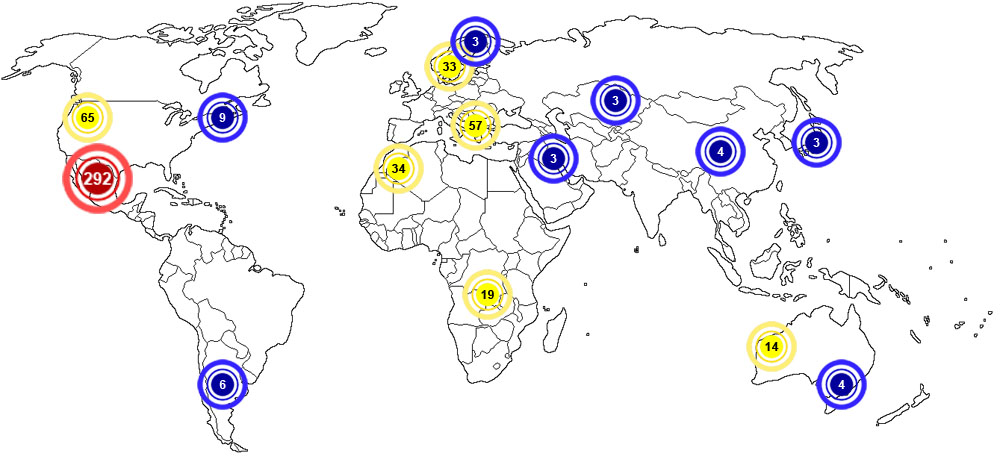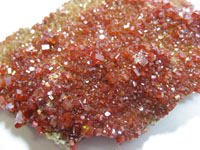![]()
Vanadinite was originally discovered in Mexico by the Spanish mineralogist Andrés Manuel del Río in 1801. He called the mineral "brown lead" and asserted that it contained a new element, which he first named pancromium and later, erythronium. However, he was later led to believe that this was not a new element but merely an impure form of chromium. In 1830, Nils Gabriel Sefström discovered a new element, which he named vanadium. It was later revealed that this was identical to the metal discovered earlier by Andrés Manuel del Río. Del Río's "brown lead" was also rediscovered, in 1838 in Zimapan, Hidalgo, Mexico, and was named vanadinite because of its high vanadium content. Other names that have since been given to vanadinite are johnstonite and lead vanadate. Altough vanadinite was first discovered in Mexico, vanadinite deposits have since been unearthed in South America, Europe, Africa, and in other parts of North America.
![]()
Within the metaphysical realm of minerals, Vanadinite allows the believer to attain a deep state of meditation, allowing their mind to be entirely void of course. This can promote order to a believer's life, helping to define their goals, and to pursue these goals in an orderly, organized manner. Vanadinite can assist a believer in circular breathing during meditation as well. Vanadinite is a stone of service; it is very active on the physical plane, inspiring action in relation to a believer's goals. It can promote thrift in spending by conserving your energy or money and is generally a good crystal to use in manifestation or prosperity work.
Please note that MIROFOSS does not suggest in any way that minerals should be used in place of proper medical and psychological care. This information is provided here as a reference only.
![]() Vanadinite is one of the main industrial ores of the element vanadium and a minor source of lead.
Vanadinite is one of the main industrial ores of the element vanadium and a minor source of lead.
![]()
Vanadinite is a secondary mineral in the oxidized zone of lead bearing deposits.
![]()
Vanadinite is a dense, brittle mineral, it is usually found in the form of red hexagonal crystals. It is an uncommon mineral, found in arid climates and formed by the oxidation of lead ore deposits such as galena. Vanadinite is a mineral belonging to the apatite group of phosphates. Crystals of vanadinite conform to a hexagonal system of symmetry. This internal structure is often reflected in the hexagonal external shape of the crystals. The crystals are usually in the form of short hexagonal prisms, but can also be found as hexagonal pyramids, rounded masses or crusts.
Other than in the basic mineral form, vanadinite can be found in two distinct varieties:
![]()
| Cleavage | None | |
| Colour(s) | Brown, Brownish yellow, Brownish red, Yellow, Colourless | |
| Specific Gravity | 6.94 | |
| Diaphaneity | Sub transparent to Opaque | |
| Fracture | Brittle - Conchoidal - Very brittle fracture producing small, conchoidal fragments | |
| Mohs Hardness | 3.5 to 4.0 | |
| Luminescence | Non-fluorescent | |
| Lustre | Adamantine | |
| Streak | Brownish yellow | |
| Habit(s) | Globular to Nodular to Prismatic | |
| Radioactivity | Non-radioactive | |
| Magnetism | Non-magnetic |
![]()
The following health hazards should be noted when handling vanadinite:
 |
BIOHAZARD Vanadinite contains the element lead which is known to cause long term health effects. |
![]()
The following image shows the elemental breakdown of the mineral vanadinite along with the mineral crystal structure:

![]()
| Crystal System | Hexagonal |  |
| Class | Dipyramidal | |
| Axial Ratios | a : c = 1 : 0.711 | |
| Optical Data Type | Well developed hexagonal prisms with smooth faces and sharp edges | |
| Pleochroism (x) | Uniaxial (-) | |
| Pleochroism (y) | Light | |
| RL Values | Dark | |
| 2V | Weak |  |
| Max Birefringence | nω = 2.416 nε = 2.350 | |
| Surface Relief | δ = 0.066 (See colour chart at right) | |
| Dispersion | Very high | |
| Notes: | Visible in tinted material in transmitted light |
![]()
Vanadinite can be referenced in certain current and historical texts under the following three names:
The mineral vanadinite can be translated into the following select languages:
| Arabic | فانادينيت | Bulgarian | Chinese (Sim) | 钒铅矿 | |
| Croatian | Czech | Danish | |||
| Dutch | Vanadiniet | Esperanto | Estonian | ||
| Finnish | Vanadiniitti | French | Plomb brun | German | Vanadinit |
| Greek | Βαναδινίτης | Hebrew | Hungarian | ||
| Italian | Vanadinite | Japanese | バナヂンナイと | Korean | 바낟인아이드 |
| Latin | Lithuanian | Vanadinitas | Norwegian | ||
| Persian | Polish | Wanadynit | Portuguese | Vanadinita | |
| Romanian | Vanadinit | Russian | Ванадинит | Slovak | |
| Spanish | Vanadinita | Swedish | Vanadinit | Tagalog | |
| Turkish | Ukrainian | Ванадиніт | Vietnamese |
![]()
Vanadinite can be found in a few select locations around the world. The map below shows major documented concentrations of vanadinite:


![]()
 |
The MIROFOSS database offers free printable geological identification tags for personal and non-profit use. These tags can be used to properly identify mineral samples in your collection. -Click here- to download a full size jpeg image for a vanadinite identification tag; which can be printed on paper or used with a plastic laser printer. |
 |
What's this? What can I do with it? |
![]()
| Crystallography | Laufek, F., Skála, R., Haloda, J., Cisařová, I. (2006): Crystal structure of vanadinite: Refinement of anisotropic displacement parameters. Journal of the Czech Geological Society, 51(3-4), 271-275. |
| Crystallography | Baker, W. E. (1966): An X-ray diffraction study of synthetic members of the pyromorphite series. American Mineralogist 51, 1712-1721. |
| History | Anthony, J.W., Bideaux, R.A., Bladh, K.W., and Nichols, M.C. (2000) Handbook of Mineralogy, Volume IV. Arsenates, Phosphates, Vanadates. Mineral Data Publishing, Tucson, AZ, 680pp.: 616. |
| History | Canadian Mineralogist (1989): 27: 189. |
| Geographical Data | Mindat.org. Retrieved on 2012-06-18 |
| Physical Identification | Webmineral.com. Retrieved on 2012-06-18. |
| June 25, 2014 | The last time this page was updated |
| ©2018 MIROFOSS™ Foundation | |
 |
|






